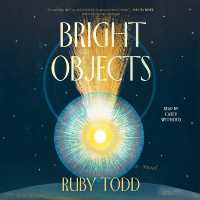- ホーム
- > 洋書
- > 英文書
- > Science / Mathematics
基本説明
Reviews the range of detection techniques and their application in detecting particular types of residue. Contents: Classifying food allergens; The use of antibodies to detect allergens in food; Allergen-specific human IgE antibody-based analysis of food; Immunoblotting in allergen detection; Methods for detecting peanuts in food; Detecting tree nuts and seeds in food; Detecting soy, fish and crustaceans in food; Allergen quality assurance for hypoallergenic formula; US regulation of undeclared allergens in food products; and more.
Full Description
Food allergies are an increasing health issue in Western societies, presenting a major challenge for the food industry. As a result there has been a wealth of research into developing effective methods for detecting allergenic residues in food. Detecting allergens in food reviews the range of detection techniques and their application to all the main allergens in food.The first part of the book introduces the nature of food allergy and the range of plant and animal-derived food allergens. Part two reviews the range of detection methods from the use of antibodies in immunoblotting and enzyme-linked immunosorbent assays (ELISAs) to polymerase chain reaction (PCR) methods and the use of lateral flow devices. Building on this foundation, Part three looks at detection methods for particular allergenic foods, from peanuts, tree nuts and seeds to dairy and egg residues, wheat gluten, soy, fish and crustaceans. The final part of the book looks at key issues in using detection methods effectively and the regulatory context in the USA and EU.With its distinguished editors and international team of contributors, Detecting allergens in food is a standard reference work for the food industry.
Contents
Part 1 The basics of food allergyClassifying food allergens. Part 2 Types of detection method: Antibodies; Allergen-specific human IgE antibody-based analysis of food; Immunoblotting in allergen detection; Enzyme-linked immunosorbent assays (ELISAs) for detecting allergens in foods; Polymerase chain reaction (PCR) methods for the detection of allergenic foods; Proteomic assessment of allergens in food; Detecting food allergens with a surface plasmon resonance immunoassay; The use of lateral flow devices to detect food allergens. Part 3 Detection methods for particular allergens: Methods for detecting peanuts in food; Detecting tree nuts and seeds in food; Detecting dairy and egg residues in food; Detecting wheat gluten in food; Detecting soy, fish and crustaceans in food. Part 4 Issues in using allergen detection methods: Allergen quality assurance for hypoallergenic formula; Common issues in detecting allergenic residues on equipment and in processed foods; Factors affecting the effectiveness of allergen detection; Reference materials and method validation in allergen detection; US regulation of undeclared allergens in food products; EU regulation of undeclared allergens in food products.








